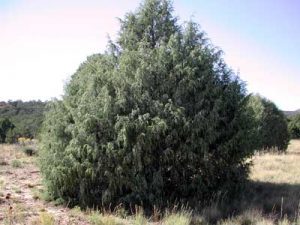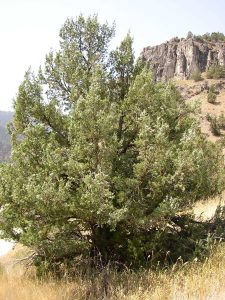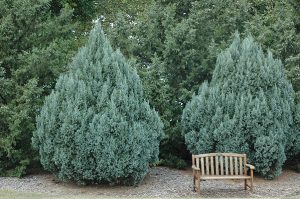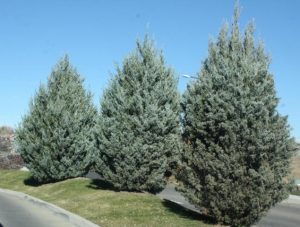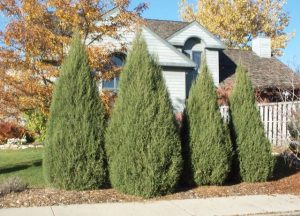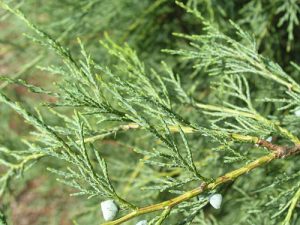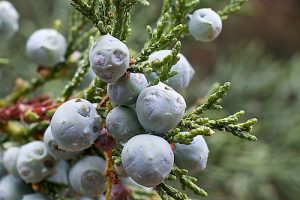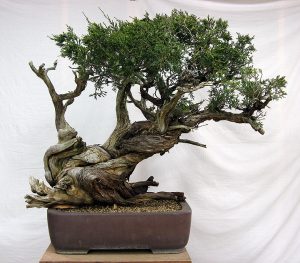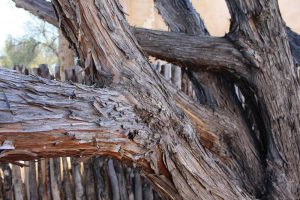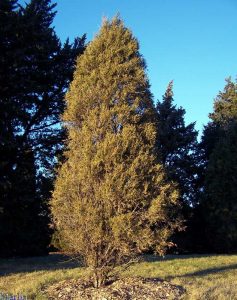Rocky Mountain Juniper
Rocky Mountain Juniper is a small- to medium-sized coniferous tree native to North America, growing at an elevation of about 500-2700 meters (1600-8900 ft) on dry soils usually with other juniper species. It has a wide, irregular crown and twisted trunk.
Scientific Classification
| Kingdom | Plantae |
| Division | Pinophyta |
| Class | Pinopsida |
| Order | Pinales |
| Family | Cupressaceae |
| Genus | Juniperus |
| Scientific name | Juniperus scopulorum |
Quick Information
| Other Names | Mountain Red Cedar, Rocky Mountain Cedar, Cedar Tree, Juniper Bush, Savin, Evergreen, Cedar Apple |
| Similar to | Eastern Red Cedar |
| Size | Height ranging between 5 to 10 m (sometimes more) with trunk thickness up to 1 or 2 m and diameter up to 300 mm (rarely 600 mm) |
| Leaves | Arranged in opposite pairs at right angles, sometimes in whorls of three; scaly adult leaves, 1-2 mm long, 1-1.5 mm broad; needle-shaped young leaves on seedlings, 5-10 mm long |
| Cones | Seed Cones: Berry-like ball shaped and bilobed with a diameter ranging from 6-9 mm, dark blue, consists of two seeds (occasionally one or three); takes about 18 months to mature Pollen Cones: 2-4 mm long, dioecious, pollen are shed in early spring |
| Tree Type | Perennial, evergreen |
| Shape at Maturity | Pyramidal, columnar |
| Distribution/Range | Western North America, British Columbia and Alberta in Canada; east of Washington, North Dakota, western Texas, and south to Arizona in the United States; from east of Sonora to Coahuila in northernmost Mexico |
| Hardiness Zones | 4 to 8 |
| Lifespan | 250-300 years or more |
| Growth rate | Usually slow-growing |
| Growing Conditions | Water requirement: Low; can tolerate drought Light requirement: Direct sunlight as well as partial shade Cold exposure: Can tolerate cold; cannot adapt to high night temperature; cannot survive when exposed to temperature below -38°F Humidity: Not tolerant of high humidity Soil Requirement: Dry, sandy, rocky, clayey, slightly alkaline; high calcium-carbonate tolerance |
| Diseases/Pests | It is vulnerable to attack by a complex of insects, arachnids, and nematodes; it is attacked by blights, juniper berry mites, and red spider mites; it is an alternate host for cedar apple rust |
| Flowering/Fruiting | April, May |
| Seed Production | Seeds are occasionally borne at 10 years of age though the optimum time for production of seeds is 50-200 years |
| Seed-bearing Frequency | It bears seeds every year, but heavier production takes place every 2 to 5 years |
| Dispersal of Seeds | Ripen and fall off from the tree during the second spring, dispersed by different birds and small mammals |
| Wildlife Value | Provides nesting place, fruits, and dense cover for many wildlife species |
| Cultivars | Many cultivars have been used in horticulture – Skyrocket, Blue Arrow, Welch Juniper, Blue Haven, Blue Trail Cologreen, Winter Blue, Pathfinder, Gray Gleam, Springbark, Platinum, Green Ice, Moonglow, Greenspice, Wichita Blue, etc |
| Uses | Plateau Indian people made a drink from the inner barks and leaves for the treatment of coughs and fevers; the berries were used for their laxative and cold-relieving properties; the wood is used for making furniture, fence posts, interior paneling, fuel, and chests |
| IUCN Conservation Status | Least Concern |
Interesting Facts
- In October 1804, the rocky mountain juniper was initially discovered by Lewis and Clark
- In the United States, it is popularly collected for bonsai.
References:
- https://www.for.gov.bc.ca/hfd/library/documents/treebook/rockymountainjuniper.htm
- https://en.wikipedia.org/wiki/Juniperus_scopulorum
- https://www.fs.usda.gov/database/feis/fire_regimes/Northern_RM_juniper/all.html
- https://www.fs.usda.gov/database/feis/plants/tree/junsco/all.html
- https://plants.usda.gov/DocumentLibrary/factsheet/pdf/fs_jusc2.pdf


